中美家庭情景喜剧对比
- 格式:ppt
- 大小:1.23 MB
- 文档页数:12
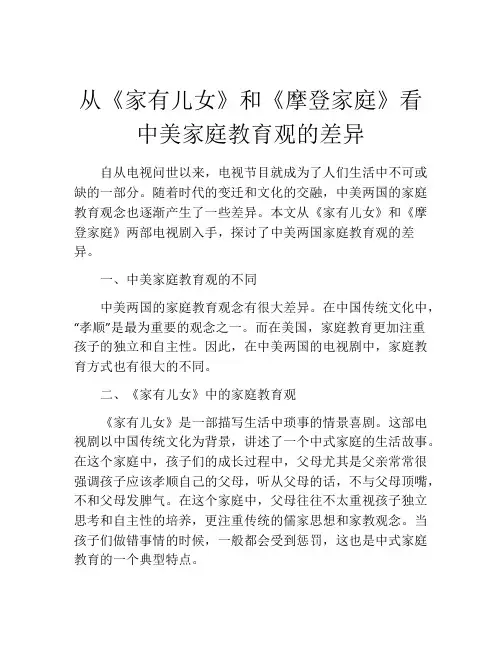
从《家有儿女》和《摩登家庭》看中美家庭教育观的差异自从电视问世以来,电视节目就成为了人们生活中不可或缺的一部分。
随着时代的变迁和文化的交融,中美两国的家庭教育观念也逐渐产生了一些差异。
本文从《家有儿女》和《摩登家庭》两部电视剧入手,探讨了中美两国家庭教育观的差异。
一、中美家庭教育观的不同中美两国的家庭教育观念有很大差异。
在中国传统文化中,“孝顺”是最为重要的观念之一。
而在美国,家庭教育更加注重孩子的独立和自主性。
因此,在中美两国的电视剧中,家庭教育方式也有很大的不同。
二、《家有儿女》中的家庭教育观《家有儿女》是一部描写生活中琐事的情景喜剧。
这部电视剧以中国传统文化为背景,讲述了一个中式家庭的生活故事。
在这个家庭中,孩子们的成长过程中,父母尤其是父亲常常很强调孩子应该孝顺自己的父母,听从父母的话,不与父母顶嘴,不和父母发脾气。
在这个家庭中,父母往往不太重视孩子独立思考和自主性的培养,更注重传统的儒家思想和家教观念。
当孩子们做错事情的时候,一般都会受到惩罚,这也是中式家庭教育的一个典型特点。
三、《摩登家庭》中的家庭教育观与《家有儿女》不同,《摩登家庭》是一部讲述美国白人家庭的情景喜剧。
在这个电视剧中,家庭教育方式相对而言更加注重孩子的独立思考和自主性的培养。
这个家庭中的父母并不总是强调孩子们应该听从他们的话,而是更多地倾听孩子的想法和意见,让孩子们更多地参与到家庭中来。
在这个家庭中,父母并不会太过严厉地对待孩子犯错的行为,而是尽可能地通过交流和教育,让孩子们学会从错误中成长和进步。
四、中美家庭教育观的比较从《家有儿女》和《摩登家庭》两部电视剧中,我们可以看出中美两国的家庭教育观念存在一些差异。
相对而言,在中国传统文化中,孝顺是最为重要的观念之一。
因此,中式家庭教育更注重孩子们孝敬父母,听从父母的话,不与父母顶嘴,不和父母发脾气。
而在美国,家庭教育更加注重孩子的独立和自主性。
这一点也体现在《摩登家庭》中。
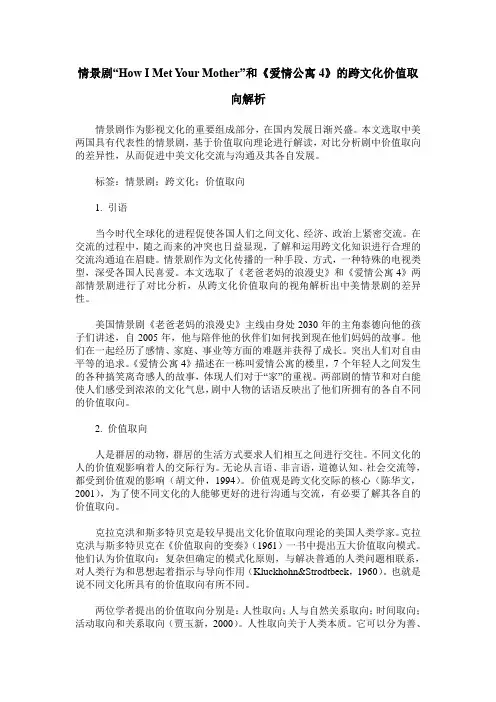
情景剧“How I Met Your Mother”和《爱情公寓4》的跨文化价值取向解析情景剧作为影视文化的重要组成部分,在国内发展日渐兴盛。
本文选取中美两国具有代表性的情景剧,基于价值取向理论进行解读,对比分析剧中价值取向的差异性,从而促进中美文化交流与沟通及其各自发展。
标签:情景剧;跨文化;价值取向1. 引语当今时代全球化的进程促使各国人们之间文化、经济、政治上紧密交流。
在交流的过程中,随之而来的冲突也日益显现,了解和运用跨文化知识进行合理的交流沟通迫在眉睫。
情景剧作为文化传播的一种手段、方式,一种特殊的电视类型,深受各国人民喜爱。
本文选取了《老爸老妈的浪漫史》和《爱情公寓4》两部情景剧进行了对比分析,从跨文化价值取向的视角解析出中美情景剧的差异性。
美国情景剧《老爸老妈的浪漫史》主线由身处2030年的主角泰德向他的孩子们讲述,自2005年,他与陪伴他的伙伴们如何找到现在他们妈妈的故事。
他们在一起经历了感情、家庭、事业等方面的难题并获得了成长。
突出人们对自由平等的追求。
《爱情公寓4》描述在一栋叫爱情公寓的楼里,7个年轻人之间发生的各种搞笑离奇感人的故事,体现人们对于“家”的重视。
两部剧的情节和对白能使人们感受到浓浓的文化气息,剧中人物的话语反映出了他们所拥有的各自不同的价值取向。
2. 价值取向人是群居的动物,群居的生活方式要求人们相互之间进行交往。
不同文化的人的价值观影响着人的交际行为。
无论从言语、非言语,道德认知、社会交流等,都受到价值观的影响(胡文仲,1994)。
价值观是跨文化交际的核心(陈华文,2001),为了使不同文化的人能够更好的进行沟通与交流,有必要了解其各自的价值取向。
克拉克洪和斯多特贝克是较早提出文化价值取向理论的美国人类学家。
克拉克洪与斯多特贝克在《价值取向的变奏》(1961)一书中提出五大价值取向模式。
他们认为价值取向:复杂但确定的模式化原则,与解决普通的人类问题相联系,对人类行为和思想起着指示与导向作用(Kluckhohn&Strodtbeck,1960)。
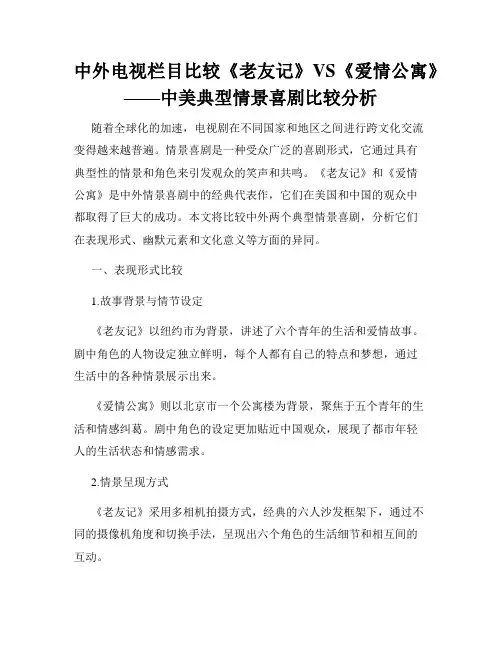
中外电视栏目比较《老友记》VS《爱情公寓》——中美典型情景喜剧比较分析随着全球化的加速,电视剧在不同国家和地区之间进行跨文化交流变得越来越普遍。
情景喜剧是一种受众广泛的喜剧形式,它通过具有典型性的情景和角色来引发观众的笑声和共鸣。
《老友记》和《爱情公寓》是中外情景喜剧中的经典代表作,它们在美国和中国的观众中都取得了巨大的成功。
本文将比较中外两个典型情景喜剧,分析它们在表现形式、幽默元素和文化意义等方面的异同。
一、表现形式比较1.故事背景与情节设定《老友记》以纽约市为背景,讲述了六个青年的生活和爱情故事。
剧中角色的人物设定独立鲜明,每个人都有自己的特点和梦想,通过生活中的各种情景展示出来。
《爱情公寓》则以北京市一个公寓楼为背景,聚焦于五个青年的生活和情感纠葛。
剧中角色的设定更加贴近中国观众,展现了都市年轻人的生活状态和情感需求。
2.情景呈现方式《老友记》采用多相机拍摄方式,经典的六人沙发框架下,通过不同的摄像机角度和切换手法,呈现出六个角色的生活细节和相互间的互动。
《爱情公寓》则以对话为主要表现方式,通过五个角色之间的对话和互动来展现人物之间的关系和故事的发展。
也采用了适度的透视镜头和动画元素,增添了一些幽默和夸张的效果。
二、幽默元素比较1.笑点创作《老友记》通过情节的设置和台词的幽默创作带给观众持续的笑点。
剧中角色的个性特点和搞笑片段的设置非常巧妙,毫不雷同且充满创意。
同时,不少台词也成为了经典的梗,深入人心。
《爱情公寓》着重通过语言和段子来制造笑点。
剧中角色的对白具有智慧性和戏剧性,贴合中国年轻观众的口味和文化背景,引发了广大观众的共鸣和笑声。
2.情绪营造《老友记》通过较为轻松的剧情和场景,营造出快乐、轻松的氛围,使观众忘却压力,享受片中角色的生活点滴。
《爱情公寓》采用了较为真实和贴近生活的情节,与观众情感上的共鸣更加紧密。
剧中角色所面对的问题和困境,以及他们之间的友情和爱情,让观众在欢笑之余,也思考人生和情感的真谛。
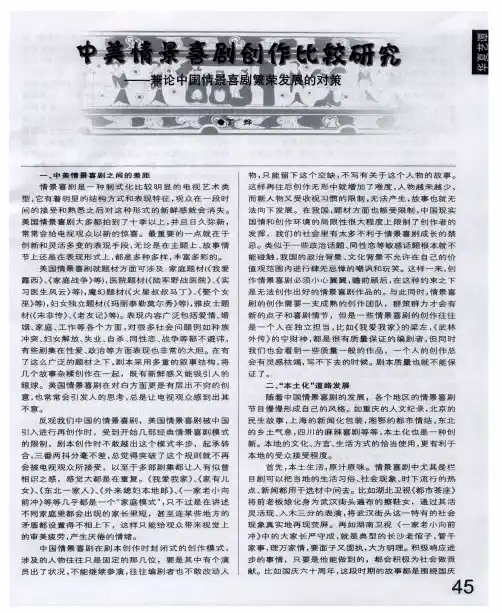

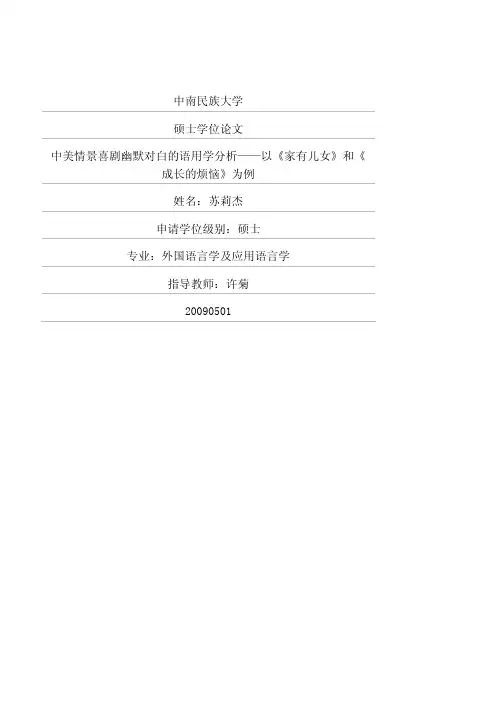
中南民族大学硕士学位论文中美情景喜剧幽默对白的语用学分析——以《家有儿女》和《成长的烦恼》为例姓名:苏莉杰申请学位级别:硕士专业:外国语言学及应用语言学指导教师:许菊20090501A Pragmatic Analysis of Verbal Humors in Chinese and American SitcomsAbstractHumor is “something causing you to smile or laugh” or “the quality of causing such amusement”. It is a popular pragmatic phenomenon because it can fulfill a lot of psychological, affective, cognitive, social or aesthetic functions. Humor has constantly been a hot topic in philosophical and linguistic fields. Among the western classical humor theories, superiority theory, relief theory and incongruity theory are the most typical ones, which interpret humor respectively in terms of the relative status between the humorist and the subject being laughed at, the psychological-affective function of humor, and the cause of humor creation. In China, Lin Yutang was one of pioneers in the field of humor studies. Many more recent researches have studied humor from linguistic, rhetorical and pragmatic perspectives.Sitcom (short for situation comedy) is a humorous drama based on the situation that might arise in everyday life. To make the audience laugh is one of the most essential ingredients and the ultimate goal of sitcoms. Nowadays sitcom has been established as a mature comic literary genre and part of the staple diet of mainstream television entertainment around the world. Among the American and Chinese sitcoms, Growing Pains and Home with Kids are the most popular ones, both of which are developed in a family setting with loving parents and lovely kids of different characters. Sitcom is a relatively new literary and television genre, so its researches are relatively rare, especially those done from pragmatic perspective.Based on the previous researches, the present study makes a tentative exploration into the underlying mechanisms of the verbal humor presented in Chinese and American sitcoms Home with Kids and Growing Pains, within the framework of two pragmatic theories, namely, Grice’s Cooperative Principle and Leech’s Politeness Principle. It is found, based on a qualitative analysis of a great sum of data, that a violation of CP and PP maxims can result in the generation of a lot of humor. Another important finding concerns the pragmatic strategies applied in Chinese and American verbal humors, which are discriminated along micro-macro dimension.中南民族大学硕士学位论文Micro-pragmatic strategies refer to those realized at the phonetic, lexical and rhetorical levels such as variation in pitch and stress patterns, the use of rhyme, homophones or homographs, coinage or nonce words, figures of speech, etc. Macro-pragmatic strategies refer to those oriented at establishing solidarity, aggression and self-defense. Solidarity-oriented strategies are presented as sharing experience, highlighting similarities and jesting while aggression-oriented strategies presented as conflict fostering, imposition and ridiculing. Defense-oriented strategies are concretely realized in forms of confessing, coping, self-denigrating and concealing.The present thesis is concluded by pointing out the theoretical, communicative and pedagogical implications of the research. Theoretically, the present study of sitcom humor demonstrates a great potentiality of pragmatic theories in interpreting linguistic and literary phenomena and indicates a new direction for further literary pragmatic researches. Communicatively, the fact that the audience enjoys watching sitcoms implicates that humorous language and characters can facilitate the success of communication and make one more popular with others. Pedagogically, American sitcoms, which are loaded with humorous English language, cultural knowledge and social values, are the ideal material for both language and culture teaching to the EFL learners.There is no doubt the present research has some limitations. For instance, only two pragmatic theories (CP and PP) have been applied in the interpretation of verbal humor occurring in the chosen sitcoms, leaving other equally or even more important theories (e.g. RT) untouched; this thesis is focused exclusively on the verbal humor in sitcoms, leaving humor in other forms unexplored, etc. These inadequacies should be taken as a reminder for the further studies of the same field.Key words: verbal humor; situation comedies; pragmatic apparatuses; pragmatic strategiesA Pragmatic Analysis of Verbal Humors in Chinese and American Sitcoms摘要幽默既指逗乐之事,又指逗乐之性。
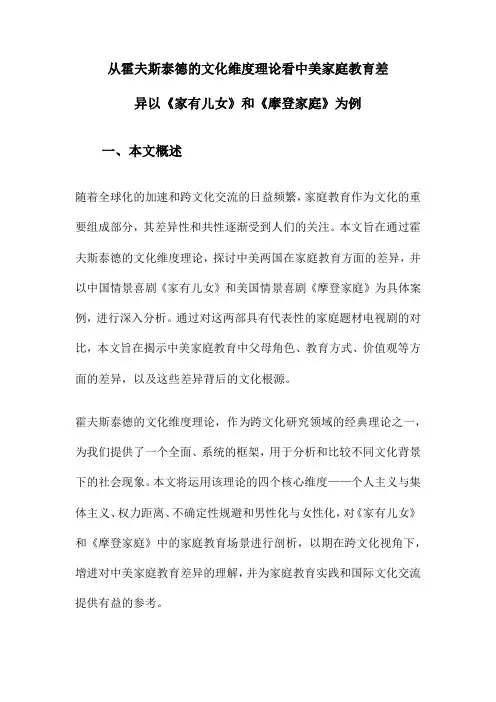
从霍夫斯泰德的文化维度理论看中美家庭教育差异以《家有儿女》和《摩登家庭》为例一、本文概述随着全球化的加速和跨文化交流的日益频繁,家庭教育作为文化的重要组成部分,其差异性和共性逐渐受到人们的关注。
本文旨在通过霍夫斯泰德的文化维度理论,探讨中美两国在家庭教育方面的差异,并以中国情景喜剧《家有儿女》和美国情景喜剧《摩登家庭》为具体案例,进行深入分析。
通过对这两部具有代表性的家庭题材电视剧的对比,本文旨在揭示中美家庭教育中父母角色、教育方式、价值观等方面的差异,以及这些差异背后的文化根源。
霍夫斯泰德的文化维度理论,作为跨文化研究领域的经典理论之一,为我们提供了一个全面、系统的框架,用于分析和比较不同文化背景下的社会现象。
本文将运用该理论的四个核心维度——个人主义与集体主义、权力距离、不确定性规避和男性化与女性化,对《家有儿女》和《摩登家庭》中的家庭教育场景进行剖析,以期在跨文化视角下,增进对中美家庭教育差异的理解,并为家庭教育实践和国际文化交流提供有益的参考。
二、霍夫斯泰德文化维度理论概述霍夫斯泰德的文化维度理论是由荷兰心理学家吉尔特·霍夫斯泰德提出的一种跨文化研究框架,旨在解析和比较不同文化背景下的价值观和行为模式。
该理论通过五个核心维度——权力距离、不确定性规避、个人主义与集体主义、男性化与女性化、长期取向与短期取向,来全面揭示各国文化的深层结构。
权力距离指的是一个社会对权力分配不平等的接受程度。
在权力距离较大的文化中,人们普遍接受并尊重权威和地位差异,而在权力距离较小的文化中,人们则更加强调平等和公正。
不确定性规避涉及一个社会对模糊和不确定性的容忍度。
不确定性规避程度高的文化倾向于制定严格的规则和程序来避免混乱,而规避程度低的文化则更加灵活和开放。
第三,个人主义与集体主义维度描述的是文化中个体与集体之间的关系。
在个人主义文化中,个人的权利和自由至关重要,而在集体主义文化中,群体的和谐和利益则被放在首位。
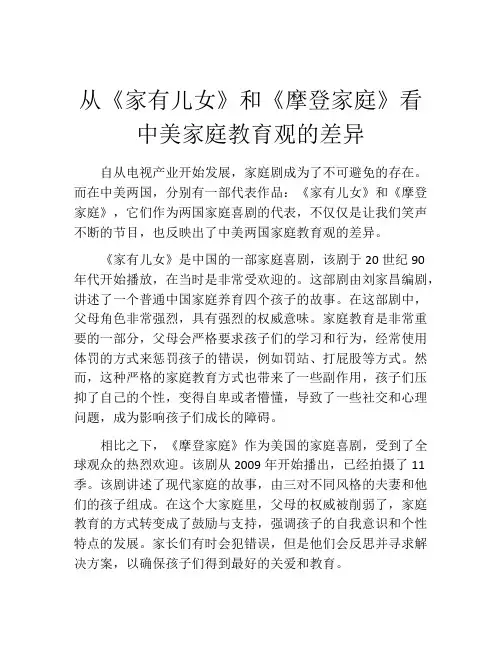
从《家有儿女》和《摩登家庭》看中美家庭教育观的差异自从电视产业开始发展,家庭剧成为了不可避免的存在。
而在中美两国,分别有一部代表作品:《家有儿女》和《摩登家庭》,它们作为两国家庭喜剧的代表,不仅仅是让我们笑声不断的节目,也反映出了中美两国家庭教育观的差异。
《家有儿女》是中国的一部家庭喜剧,该剧于20世纪90年代开始播放,在当时是非常受欢迎的。
这部剧由刘家昌编剧,讲述了一个普通中国家庭养育四个孩子的故事。
在这部剧中,父母角色非常强烈,具有强烈的权威意味。
家庭教育是非常重要的一部分,父母会严格要求孩子们的学习和行为,经常使用体罚的方式来惩罚孩子的错误,例如罚站、打屁股等方式。
然而,这种严格的家庭教育方式也带来了一些副作用,孩子们压抑了自己的个性,变得自卑或者懵懂,导致了一些社交和心理问题,成为影响孩子们成长的障碍。
相比之下,《摩登家庭》作为美国的家庭喜剧,受到了全球观众的热烈欢迎。
该剧从2009年开始播出,已经拍摄了11季。
该剧讲述了现代家庭的故事,由三对不同风格的夫妻和他们的孩子组成。
在这个大家庭里,父母的权威被削弱了,家庭教育的方式转变成了鼓励与支持,强调孩子的自我意识和个性特点的发展。
家长们有时会犯错误,但是他们会反思并寻求解决方案,以确保孩子们得到最好的关爱和教育。
两部剧存在的差异,反映出中美两国的家庭教育观念的差异。
在中国,家长们经常将自己的期望和要求强加给孩子们,往往关注学习成绩和职业选择,而忽略了孩子们的兴趣和爱好,这种过度保护加上强制教育常常压抑孩子们的个性。
而在美国的家庭中,家长们更多地关注孩子们的自由和特点,尽可能地鼓励孩子们的个性发展,并且对于孩子的不同选择、不同意见也时常予以支持和尊重。
这种教育方式不但对孩子们有更大的尊重和肯定,还可以让孩子们有更加开放的心态和更丰富的生活经验。
当然,这并不能说明中美两种家庭教育方式哪一种明显更好,这取决于家庭习惯、文化传统和个人的偏好,教育方式也不能一概而论。

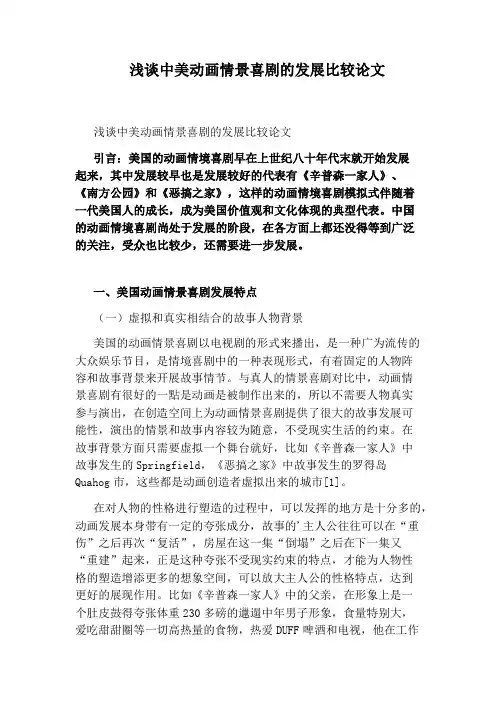
浅谈中美动画情景喜剧的发展比较论文浅谈中美动画情景喜剧的发展比较论文引言:美国的动画情境喜剧早在上世纪八十年代末就开始发展起来,其中发展较早也是发展较好的代表有《辛普森一家人》、《南方公园》和《恶搞之家》,这样的动画情境喜剧模拟式伴随着一代美国人的成长,成为美国价值观和文化体现的典型代表。
中国的动画情境喜剧尚处于发展的阶段,在各方面上都还没得等到广泛的关注,受众也比较少,还需要进一步发展。
一、美国动画情景喜剧发展特点(一)虚拟和真实相结合的故事人物背景美国的动画情景喜剧以电视剧的形式来播出,是一种广为流传的大众娱乐节目,是情境喜剧中的一种表现形式,有着固定的人物阵容和故事背景来开展故事情节。
与真人的情景喜剧对比中,动画情景喜剧有很好的一點是动画是被制作出来的,所以不需要人物真实参与演出,在创造空间上为动画情景喜剧提供了很大的故事发展可能性,演出的情景和故事内容较为随意,不受现实生活的约束。
在故事背景方面只需要虚拟一个舞台就好,比如《辛普森一家人》中故事发生的Springfield,《恶搞之家》中故事发生的罗得岛Quahog市,这些都是动画创造者虚拟出来的城市[1]。
在对人物的性格进行塑造的过程中,可以发挥的地方是十分多的,动画发展本身带有一定的夸张成分,故事的'主人公往往可以在“重伤”之后再次“复活”,房屋在这一集“倒塌”之后在下一集又“重建”起来,正是这种夸张不受现实约束的特点,才能为人物性格的塑造增添更多的想象空间,可以放大主人公的性格特点,达到更好的展现作用。
比如《辛普森一家人》中的父亲,在形象上是一个肚皮鼓得夸张体重230多磅的邋遢中年男子形象,食量特别大,爱吃甜甜圈等一切高热量的食物,热爱DUFF啤酒和电视,他在工作的时候也是在在睡觉或者吃甜甜圈,放大了好吃懒做的人物特点。
《恶搞之家》之中的家庭是由非常荒诞的家庭成员组成的,爸爸皮特格里芬是个说话不着调,好色,经常惹麻烦,智商低下且好吃的胖子。
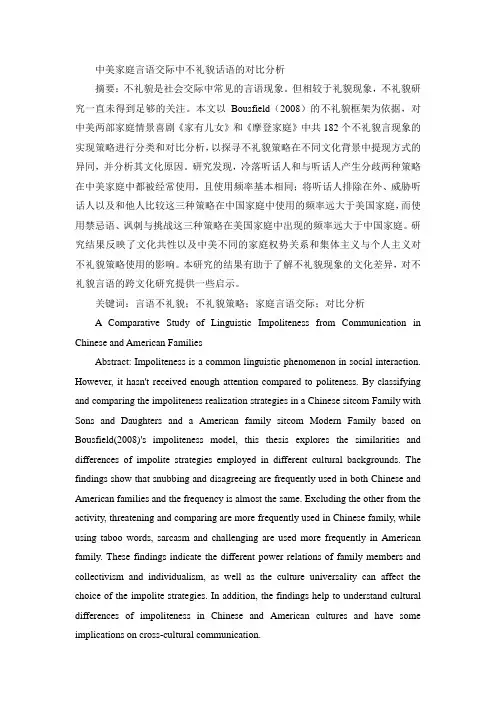
中美家庭言语交际中不礼貌话语的对比分析摘要:不礼貌是社会交际中常见的言语现象。
但相较于礼貌现象,不礼貌研究一直未得到足够的关注。
本文以Bousfield(2008)的不礼貌框架为依据,对中美两部家庭情景喜剧《家有儿女》和《摩登家庭》中共182个不礼貌言现象的实现策略进行分类和对比分析,以探寻不礼貌策略在不同文化背景中提现方式的异同,并分析其文化原因。
研究发现,冷落听话人和与听话人产生分歧两种策略在中美家庭中都被经常使用,且使用频率基本相同;将听话人排除在外、威胁听话人以及和他人比较这三种策略在中国家庭中使用的频率远大于美国家庭,而使用禁忌语、讽刺与挑战这三种策略在美国家庭中出现的频率远大于中国家庭。
研究结果反映了文化共性以及中美不同的家庭权势关系和集体主义与个人主义对不礼貌策略使用的影响。
本研究的结果有助于了解不礼貌现象的文化差异,对不礼貌言语的跨文化研究提供一些启示。
关键词:言语不礼貌;不礼貌策略;家庭言语交际;对比分析A Comparative Study of Linguistic Impoliteness from Communication in Chinese and American FamiliesAbstract: Impoliteness is a common linguistic phenomenon in social interaction. However, it hasn't received enough attention compared to politeness. By classifying and comparing the impoliteness realization strategies in a Chinese sitcom Family with Sons and Daughters and a American family sitcom Modern Family based on Bousfield(2008)'s impoliteness model, this thesis explores the similarities and differences of impolite strategies employed in different cultural backgrounds. The findings show that snubbing and disagreeing are frequently used in both Chinese and American families and the frequency is almost the same. Excluding the other from the activity, threatening and comparing are more frequently used in Chinese family, while using taboo words, sarcasm and challenging are used more frequently in American family. These findings indicate the different power relations of family members and collectivism and individualism, as well as the culture universality can affect the choice of the impolite strategies. In addition, the findings help to understand cultural differences of impoliteness in Chinese and American cultures and have some implications on cross-cultural communication.Key words: impoliteness; impolite strategies; communication in families; comparative studyThe Comparative Analysis of Impoliteness from Communication in Chinese and American Families1. IntroductionImpoliteness is a common phenomenon in the interaction of human activities. When we lay our eyes in quarrels between people, it is clear that impoliteness plays an important role in posing the actual effect. This thesis tends to analyze the discourse of two sitcoms, by employing the impoliteness theory. In this chapter, the author will present the background of the impoliteness study, and then the significance of the study, followed by the organization of this thesis.1.1 Research BackgroundHumans live in a world with languages. The effect of conversations varies by means of different ways. People feel respected when the other applies courtesy in communication. The study of politeness phenomenon has been an important topic in pragmatics, since its rise in the 1970s. The results of politeness research in the past few decades are abundant and comprehensive. Related books and papers have mushroomed, ranging from the revision of politeness theory, the classification of politeness strategies, to cross-cultural study. However, the counterpart of politeness has not yet been paid enough attention. People tend to believe that politeness is a common phenomenon, while its counterpart is a marginal one. Studies of impoliteness are scarce, let alone the comparative analysis of impolite utterances in different cultural background. (加怎样的文献?关于不礼貌的最新的文献吗?)This thesis is written in order to improve the current situation by extracting some impolite fragments in different cultural background and then making some comparison between them.1.2 Research SignificanceSince Culpeper proposed his impoliteness framework in 1996, an increasing number of scholars have come to realize the importance of impoliteness and the imbalance between politeness and impoliteness, thus more papers have been producedto pay more attention to the study of impoliteness. Bousfield is the most outstanding one who revised the impoliteness theory in 2008. However, more work still needs to be done and more research needs to be explored contrast to politeness study. Therefore, the significance of this study includes the followings:First, this paper will contribute to the previous study on impoliteness. Almost all the scholars do research on the impoliteness without comparing the data from different cultures. This paper compares different strategies used in two different cultures to reveal some cultural similarities and differences. Second, this paper emphasizes the importance of impoliteness study, and tries to make up the imbalance between the study of politeness and impoliteness. Third, this paper can help English learners and the audience to have a better understanding of the impolite utterances and then appreciate it in a more comfortable way. Thus, to some extent, it can also offer people a hand to understand the impoliteness phenomena in real life better.1.3 The Organization of This ThesisThis thesis is organised into six chapters.Chapter One makes a brief introduction to the whole study. It is comprised of background information, the significance of this research and the organization of the thesis. Chapter Two is the literature review. It makes a brief review of and comments on the exsisting studies concerning impoliteness at home and abroad, the purpose of which is to figure out the enlightenment for the thesis. Chapter Three deals with the theoretical framework. In this chapter, an explanation of the impoliteness theory of Bousfield(2008a) will be given, following by the strategies and examples from Culpeper(1996) and Bousfield(2008a). The objective of this chapter is to set criteria for the data selection and lay a foundation for the latter research. Chapter Four is methodology. First, this chapter introduces two sitcoms A Family with Sons And Daughters (Jia You Er Nv) and Modern Family briefly. Then the data collection and analysis will be given. Chapter Five is the core of the thesis. After the results are given, comparison and analysis of impolite strategies in A Family with Sons And Daughters (Jia You Er Nv) and Modern Family is carried out in the perspective of Bousfiled's impoliteness model. Chapter Six is the conclusion of the thesis. Itsummarizes the major findings, offers some implications and indicates the limitations of this study as well as some suggestions for future study.2. Literature Review2.1 Studies on impoliteness abroadAmong all the scholars concentrating on the theoretical research of impoliteness abroad, Jonathan Culpeper and Derek Bousfield have the most influence.Jonathan Culpeper contributed constantly to the studies of impoliteness (see 1996, 2003, 2005, 2011). Culpeper (1996) published a journal article "Towards an Anatomy of Impoliteness", which was a milestone in the area of impoliteness studies. The impoliteness model in this article is parallel to, but opposite in orientation to Brown and Levinson's politeness strategies. In 2003, Culpeper renewed the previous impolite strategies in collaboration with Bousfield & Wichmann. They stressed that dynamic context and prosodic aspects should also be taken into account, because the analysis showed that prosody plays an important role in making an utterance of impoliteness. Culpeper (2005) analyzed the words from Ann Robinson, a host of the British television quiz show "The Weakest Link" with his new model and finds out impolite words have entertainment function. This is a non-public impoliteness. The host does not have a kind and encouraging attitude like the host in other television shows, but shows humor by means of sarcasm and mimicry. The author believed that, in the established context of a TV entertainment quiz show, “analyzing prosody is key to understanding impoliteness”. (Culpeper, 2005: 35) In addition, Cu lpeper (2010) believed that (im)politeness can be more inherent in a linguistic expression or can be more determined by context, but neither alone can guarantee an interpretation of (im)politeness. (这一段是过去式,下一段也用过去式吗?)Culpeper's monograph Impoliteness: Using Language to Cause Offence (2011), involves almost all the concerns about impoliteness. The book absorbs the research results from pragmatics and social psychology, and gives a deep anatomy of the operational mechanism of impolite verbal behaviors. Culpeper contributes to the impoliteness study in this book as follows: (1) Culpeper gives up the distinction between positive face and negative face of the classic politeness theory, emphasizingthe role of context in the evaluation of impolite behaviors. (2) Within the framework of social pragmatics, Culpeper accepts social psychology, including the theory of context, speech act theory, schema theory, face theory and social cognition, and then constructs an integrated social-cognitive model. This is quite a systematic and comprehensive model for analysis of impoliteness. It provides explanations and instructions on both the form of impolite speech and the context in which they occur.In 2008, a monograph titled Impoliteness in Interaction was published. In this book, Bousfield assumes that Culpeper's impoliteness strategy model is not perfect, because it can not assure the objective judgment of face threatening acts in the actual operation and the vast majority of communicative acts actually use both the positive and negative politeness/impoliteness strategy. Based on an analysis of three types of corpus: parking conflict, police training and kitchen conflict, Bousfield reconstructed a simpler impoliteness model with two overarching tactics: on-record impoliteness and off-record impoliteness, the latter including sarcasm and withhold politeness, extending the scope of impoliteness study from the traditional micro utterance level to the macro discourse level. This offers a new perspective of pragmatic study.To sum up, the studies on impoliteness abroad are systematic and broad, from the research on impolite speeches in the specific context to the research on specific language output strategies and specific speech acts. It is worth noting that these studies on impoliteness theories lay a solid foundation for future study.2.2 Studies on impoliteness at homeThe research on the phenomena of impoliteness at home started later than the west and there was also a lack of systematic study. There were no linguistic monograph specialized in phenomena of impoliteness for now. The theses and articles in the journals on this field were also not sufficient. Many scholars adopted Verschueren’s Adaptation Theory as a theoret ical basis for analyzing impoliteness phenomenon, among which Li Yuansheng, Yang Zi, Yu Guosheng and Wang Chuanben have profound influence. Li Yuansheng (2006) made a comprehensive analysis on the strategic impoliteness in Chinese language according to the Adaptation Theory. His study indicated that the impolite speech act uttered by the speaker isoriented to the mental world, the social world and the physical world of the speaker and the listener. Yang Zi and Yu Guodong (2007) improved the adaptation model of contextual correlates proposed by Verschueren in his theory of linguistic choices with maneuverability and use the improved model to analyze the reasons for the generation of various impoliteness. However, the improvement didn't have a revolutionary influence on the adaptation theory. Wang Chuanben (2009) explained the generation of impolite speech act and what consequences it can analyze and bring about. He also thought that impolite speech act is the result of speaker’s effort to adapt to the communication needs.Apart from using adaptation theory to interpret impolite phenomena, scholars also made some valuable research from other aspects. For example, Xie Shijian (2009) mentioned that: “a complete politeness theory should consist of politeness strat egies and impoliteness strategies and that different scales of politeness and impoliteness can be located in the same continuum.” He tried to apply the theory of impoliteness on the interpretation of dramas. Some scholars examine the impoliteness principles. Huang Weiying and Luo Changtian (2010) analyzed both English and Chinese discourse of furiousness and find out that principles of impoliteness has its universal applicability. Wang Dili (2011) discussed the positive functions of impolite utterances in communication with the application of the theories of dynamic context in pragmatics, mainly including Sperber and Wilson's cognitive context and Verschueren’s context adaptation.To sum up, although the study on impoliteness at home is not yet mature, the quantity rises and the research perspectives are becoming more innovative.3. Theoretical Framework of the study3.1 Impoliteness Model and Realizations of Impoliteness3.1.1 Impoliteness Model of Bousfield(2008a)Bousfield (2008a) presented an impoliteness model which consists of on-record impoliteness and off-record impoliteness. The new model is based on analysis of the strong-points and shortcomings of Culpeper's (1996, 2005) impoliteness model, which consists of bald on-record impoliteness, positive impoliteness, negative impoliteness,sarcasm or mock politeness and withhold politeness.On-record impoliteness is the use of strategies designed to explicitly: (a) attack the face of an interactant; (b) construct the face of an interactant in a non-harmonious or outright conflictive way; (c) deny the expected face wants, needs, or rights of the interactant, or some combination thereof (Bousfield, 2008a: 95). In a word, the attack is made in an unambiguous way given the context in which it occurs. While off-record impoliteness is the use of strategies where the threat or damage to an interactant's face is conveyed indirectly by way of an implicature and can be cancelled (e.g., denied, or an account / post-modification / elaboration offered, etc.) but where "...one attributable intention clearly outweighs any others"(要用什么格式?) (Culpeper, 2005:44), given the context in which it occurs (Bousfield, 2008a: 95).According to this classification, it is clearly that aggravating behaviours or utterances which attack the target's face directly belong to on-record impoliteness, while those which are conveyed through an implicature caused by violation of Grice(1989)'s cooperative principles can be called off-record impoliteness. Judging whether the aggravating output strategy is on-record or off-record impoliteness depends on whether there are conversational implicatures.The following two examples respectively indicates on-record and off-record impoliteness from Bousfield (2008b) on the British Army setting.On-record impoliteness:6 S1: when you get down to C M S R shut your fucking mouth do youS2: <indistinct>...(格式不会弄)In this example, S1 uses two on-record strategies. "shut your mouth" is a direct command with the illocutionary force and the second is the use of taboo language "fucking", which is extremely impolite.Off-record impoliteness:3 S1: I have confidence in you Downes thanks forS2: sergeant excellent sergeant4 S1: agreeing with me that anytime you want to be platoon sergeant you giveS2:5 S1: me a shoutS2:(格式)In this example,the utterance of "thanks for agreeing with me" S1 uses is insincere politeness. This can be interpreted as operating sarcastically which means the apparent opposite.3.1.2 Realization strategies of impolitenessRealization of impoliteness means a certain language output strategy of how impoliteness is conveyed in interaction. Culpeper (1996) introduces the positive and negative strategies, and Bousfield (2008a) adds some more strategies on the basis of Culpeper's strategies, like "criticize", "enforce role shift", "hinder/block" and "challenge". The impoliteness realization strategies modified by Bousfield (2008a) will be presented below.(1) Ignore, snub the other -- fail to acknowledge the other's presence;(2) Exclude the other from an activity;(3) Disassociate from the other -- for example, deny association or common ground with the other; avoid sitting together;(4) Be disinterested, unconcerned, unsympathetic;(5) Use inappropriate identity makers -- for example, use title and surname whena close relationship pertains, or a nickname when a distant relationship pertains;(6) Use obscure or secretive language -- for example, mystify the other with jargon, or use a code known to others in the group, but not the target;(7) Seek disagreement -- select a sensitive topic;(8) Make the other feel uncomfortable -- for example, do not avoid silence, joke, or use small talk;(9) Use taboo words -- use swear or abusive or profane language;(10) Call the other names -- use derogatory nominations;(11) Frighten -- instill a belief that action detrimental to the other will occur;(12) Condescend, scorn or ridicule -- emphasize your relative power. Be contemptuous; Do not treat the other seriously. Belittle the other (e.g. usediminutives);(13) Invade the other's space -- literally (e.g. position yourself closer to the other than the relationship permits) or metaphorically (e.g. ask for or speak about information which is too intimate given the relationship);(14) Explicitly associate the other with a negative aspect -- personalize, use the pronouns "I" and "you"(15) Put the other's indebtedness on record(16) Criticize -- dispraise h, some action or inaction by h, or some entity in which h has invested face;(17) Hinder/block physically (block passage), communicatively (deny turn interrupt);(18) Enforce topic shift;(19) Challenges.(20) Compare -- compare a person to another who shares the same age, standing, etc.The strategies (1) to (15) are from Culpeper (1996) and were classified under positive impoliteness output strategies and negative impoliteness output strategies. However, Bousfield (2008a) discussed that there is no dichotomy between the positive and negative strategies, so I will abandon this view and just adopt its strategies. The strategies (16) to (19) are strategies not covered by Culpeper (1996) and added by Bousfield (2008a). Besides, just as Bousfield (2008a) admitted, there may be other strategies for conveying impoliteness - ones that have not been predicted in the model, "compare" is a strategy I would like to add. All these strategies will be realized by data from Modern Family and Family with Sons and Daughters(Jia YouEr Nv).4. Methodology4.1 Data Sources4.1.1 Modern FamilyAmerican sitcom Modern Family is a massive hit when released on the ABC in 2009. It is the Emmy Award winner for Outstanding Comedy Series. In the show,there are mainly three families which are related to each other, which are Jay's family, Jay's daughter Claire's family and Jay's son Mitchell's family.Jay's family is a reorganized family, which is composed of Jay, his wife Gloria and Gloria's son Manny. Jay is a successful rich businessman. His wife Gloria comes from Colombia and is quite young and beautiful. Manny is the son of Gloria and her ex-husband.Jay's son Mitchell is a gay and lives with his husband Cameron. They adopted a baby form Vietnam named Lily. Mitchell is a lawyer, while Cameron stays at home to look after the baby.Jay's daughter Claire has been married to Phil for 16 years. They have two daughters, Haley and Alex, and one son, Luke. Claire is a full-time housewife and Phil is a real estate agent. The character of their three kids varies from each other very differently. The oldest daughter Haley is very pretty but doesn't like studying. On the contrary, Alex studies very hard and is the typical good student at school. Luke, the youngest son, is a little weird from normal kids.4.1.2 Family with Sons and DaughtersFamily with Sons and Daughters(Jia You Er Nv) is a Chinese TV sitcom, which tells stories of a rebuilt family in Beijing. The hero Xia Donghai(夏东海) and the heroine Liu Mei(刘梅) were both divorced. They remarried and live together with their three children, setting up a happy family. The main characters in this family include: Xia Donghai(夏东海),the father, an editor of children play; Liu Mei(刘梅), the mother, a charge nurse; Xia Xue(夏雪),the eldest daughter of Xia Donghai, an intelligent and straight "A" student, confident while sensitive; Liu Xing(刘星),son of Liu Mei, a smart but naughty boy, who always fails in his school examinations; Xia Yu(夏雨),youngest son of Xia Donghai, an adorable and naive kid who has grown up in America and come back with his father.Although being a rebuilt family, both of the parents treat all the children as their own. They love their children deeply, paying much attention to their education. Being funny and close-to-life, the sitcom was very popular among Chinese.4.1.3 Reasons for choosing the two sitcomsFirstly, both Modern Family and Family with Sons and Daughters are family-centered sitcoms. The parents and children are the major components of a complete family. And inevitably, there always have some quarrels between parents and their children. Those quarrels provide possibility for me to research impoliteness.Secondly, two sitcoms share many similarities in plots and characters. In both families, parents are well-educated; the children diversify in their personalities. Two families both have a daughter who is an A-straight student, a son who is smart while not good at studying.Thirdly, both of the two sitcoms can be reflective in its culture background and thoughts and behaviors of the people. They are close-to-life and show the real aspect in the life of their nation.Taking all the above into consideration, these two sitcoms are chosen to investigate the impoliteness between parents and their children.4.2 Data Collection and analysisFirst, the series of the two sitcoms are collected, including five seasons, total 120 episodes of Modern Family and one season, totals 100 episodes of Family with Sons and Daughters. Then, the author examines all the episodes, finding 94 utterances of impoliteness in Modern Family and 91 utterances of impoliteness in Family with Sons and Daughters. Thus, the total research corpus consists of 185 utterances of impoliteness.The following table illustrates the realization strategies of impoliteness based on Bousfield’s model.Strategies Examplessnub I don't care what you do (Bousfield, 2008)Exclude the other from the activity Just get out of the houseDisassociate from the other I've got everybody on my sideBe uninterested, unconcerned unsympatheticYou can bubble all you wantUse inappropriate identity markers My young fellerSeek disagreement -come on-there is no come onUse taboo words What are you fucking doingthreaten Touch my fucking new car and I'll bust your fucking head offcondescend Well that's being babyish isn't itExplicitly associate the other with a negative aspect Well so was Hitlersarcasm <sarcastically> have a good dayWithhold politeness -thank you very much for coming-I don't thank you at allcriticize If you want to be like that then I can walk awayHinder/block He won't allow us to remove the vehicleEnforce role shift I'm asking you as a personChallenge Why do I have to park my car three hundred yards up the roadcompare 真是,人小雪对自己要求高,人家学什么什么成,不像你,学什么什么不成。
中美情景喜剧中的爱情观对比分析爱情在人生中扮演着至关重要的角色,这对于年轻人来说更是如此。
积极正确的爱情观让人幸福一生,而消极错误的爱情观则会带来负面甚至是毁灭性的后果。
迄今为止,关于爱情观的研究数量众多,然而大多数都是从心理学或者文学角度出发。
本文通过媒体分析和跨文化对比分析来探究中美的爱情观差异。
作为备受观众喜爱的情景喜剧,中国的《爱情公寓》和美国的《老友记》讲述的都是年轻人的日常生活,尤其是他们的恋爱生活。
以《爱情公寓》和《老友记》为案例,本文主要研究中美情景喜剧中的爱情观。
基于对《爱情公寓》和《老友记》主要角色恋爱关系的分析,揭示两部情景剧里所展现的爱情观,从中探视当代年轻人的爱情观,以及背后的文化价值观。
运用斯滕伯格的爱情三角理论,研究发现,在开启一段恋爱关系时,《爱情公寓》中的人物将个人的社会地位、家庭背景和收入等外在条件放在重要地位,而《老友记》中恋爱关系建立在强烈的激情之上。
在恋爱关系过程中,《爱情公寓》中的家人和朋友会对恋爱关系进行干预,而个人的恋爱想法也会受到影响;《老友记》中个人的恋爱关系基本上不会受到家人或朋友的干预与影响。
相比而言,《爱情公寓》中,角色们的恋爱经验少于《老友记》。
通过探究,《爱情公寓》和《老友记》里爱情观的差异源于社会取向与个人取向,长期取向与短期取向,以及克制与放纵等文化模式的区别。
同时,也可探视当代年轻人爱情观的新特点:更加丰富的恋爱经验以及更包容的性话语氛围。
研究情景喜剧中的爱情观是了解一种文化新颖有效的角度,因为情景喜剧在年轻人中很受欢迎,同时也会塑造或影响年轻人的价值观。
未来研究可以着重分析情景喜剧中所传递的爱情观对年轻人的恋爱生活有着怎样的影响。
亲子关系是以家庭生活为基础,存在于代际,主要表现为抚养、教养和赡养等基本内容的一种人际关系。
毋庸置疑,良好的亲子关系能够很大程度上促进家庭和睦、社会和谐。
中美在宗教、历史和地理等方面的巨大差异导致了其亲子相处方式迥然不同(鲍志坤,2016)。
《家有儿女》与《摩登家庭》是两部典型的家庭情景剧,充分体现了中美家庭的亲子方式。
《家有儿女》主要是讲述两个离异家庭重新结合后父母与三个孩子间发生的有趣事情,曾经引起了广大中国观众的共鸣。
而《摩登家庭》叙事对象则是三个紧密联系而又各不相同的家庭——一对普通父母与三个孩子、一对同性恋夫妇与领养的越南养女组成的三口之家、一位六十多岁的老头迎娶年轻的哥伦比亚辣妹后与其继子组成的三口之家。
该剧选取的这三个独特而又典型的家庭展示了美国这个“大熔炉”背景下,亲子间丰富多样的日常生活。
袁家丽(2015)认为,“戏剧是生活的写照。
”所以本文将通过分析这两部经典家庭剧中的片段,探析中美家庭在亲子相处过程中的不同心理、不同的相处模式,并结合亲子关系现存的问题,讨论更有利于孩子成长和社会正向发展的亲子相处方式。
1中国家庭:亲子间的“同极相斥”儒家思想中的“长幼尊卑”“长幼有序”是维护中国家庭和谐稳固的关键。
即在一个家庭中,子女理应顺从父母,孝敬父母,一切忤逆父母的行为都被认为是不孝。
受此观念的影响,许多父母认为自己才是家中的权威,往往容易忽视孩子的个人情感需求,从而造成了亲子间越来越大的心理隔阂。
(袁家丽,2017)《家有儿女》中的妈妈刘梅正是深受这种礼教的熏陶。
她认为自己的好意孩子应该全部接收,每当儿子刘星对她的决策产生质疑,一句“我是你妈”总让孩子哑口无言。
例如,在该剧的第三部第二集中,刘梅因为小雨不弹钢琴,心疼两万元的钢琴闲置落灰,便逼迫五音不全的刘星去学钢琴。
以下是妈妈刘梅和儿子刘星的对话:刘星:干嘛我学钢琴啊?刘梅:这不你的心愿吗?中美家庭亲子关系的对比分析——以《家有儿女》和《摩登家庭》为例□周秋璐祁文慧南京林业大学外国语学院[摘要]良好的亲子关系是家庭和睦、社会和谐的关键,对于年轻一代的培养和社会关系的良性发展也有着重大意义。
从跨文化语用角度比较中美情景喜剧中的言语幽默摘要:语言是文化的重要组成部分,而喜剧则是体现文化差异和相似的重要方式之一。
本文从跨文化语用角度,比较中美情景喜剧中的言语幽默。
通过对两个国家喜剧中的隐喻、谐音、双关语、口误、玩语言等幽默技巧的分析,揭示了中美文化差异对于言语幽默的影响。
研究发现,中美幽默文化具有相似之处,如对于搞笑、滑稽的追求;同时也存在很多差异,比如西方文化对于自嘲、讽刺的接受度较高,而中国文化则更强调文化底线和人格尊严。
论文的研究对于增进中美文化的相互了解和交流具有一定的参考价值。
关键词:跨文化语用;情景喜剧;言语幽默;文化差异一、引言喜剧是舞台艺术中的一种,通过编辑和演员的表演,使观众在欢笑中得到愉悦和放松。
情景喜剧是喜剧中的一种,其特点是剧情简单,内容轻松,通过人物之间的互动以及语言上的幽默表现出人性的弱点,呈现出生活中的滑稽、搞笑之处。
情节的发展常常出乎观众的意料,因而形成了观众的狂喜。
言语幽默是情景喜剧中常见的一种幽默表现方式。
它以言语为手段,在双关语、谐音、隐喻、俚语等技巧上寻找玩笑的点。
并试图通过这些技巧,引发观众的想象力和思维活跃,让人产生强烈的心理共鸣。
本文将以中美情景喜剧中的言语幽默为主要研究对象,通过跨文化语用角度进行分析,探讨中美两个国家不同文化背景对于言语幽默的影响,以及表现出的文化差异。
通过对文化差异的深入分析,本文致力于进一步增进中美的跨文化交流和相互了解。
二、中美幽默文化的相似之处幽默是一种人类共通的心理情感和文化现象,因此在中美两个国家的幽默文化中存在一些相似的表现特点。
1. 对于搞笑、滑稽的欣赏搞笑和滑稽是情景喜剧中最基本的元素之一。
在中国著名的情景喜剧《欢乐喜剧人》中,观众们最深刻的印象之一就是这部喜剧的搞笑剪辑。
而在美国的情景喜剧中,像《老友记》、《生活大爆炸》这样的喜剧也是以讽刺、幽默为主要表现手段。
2. 对于社会、文化现象的讽刺幽默常常被看作是社会对某种现象的讽刺和批评。
中美情景剧中亲子冲突互动过程的比较研究的开题报告一、研究背景和意义近年来,中美情景剧在国内受到越来越多的关注和喜爱,其涵盖的题材和语言风格各具特色。
其中,亲子关系是情景剧中常见的主题之一。
中美两国虽然文化背景不同,但在亲子关系中的冲突和互动过程存在着共通性和差异性。
研究中美情景剧中亲子冲突互动过程的比较可以深入探讨两国文化差异,为中美两国文化交流提供借鉴和参考。
二、研究目的和问题本研究旨在比较中美情景剧中亲子冲突互动过程的异同,探究其中的文化因素,以期深入理解两国文化背景的差异,为中美文化交流提供参考和借鉴。
具体问题如下:1. 中美情景剧中亲子冲突互动的表现形式有哪些异同之处?2. 中美情景剧中亲子冲突的根源及解决方式有何不同?3. 文化因素对中美情景剧中亲子冲突互动的影响是什么?三、研究内容和方法本研究将选择数部代表性的中美情景剧作为研究对象,通过对剧中亲子冲突互动的情节、角色形象、语言表现等方面的比较分析,探究中美情景剧中亲子冲突互动的异同之处和文化背景的影响因素。
具体方法包括文献分析法、剧本分析法、案例分析法、访谈法和问卷调查法等。
其中,访谈法和问卷调查法将采用定性和定量相结合的方式进行,以获取实际观众对中美情景剧中亲子冲突互动的看法和评价。
四、研究预期成果和局限性本研究的预期成果是对中美情景剧中亲子冲突互动的异同之处和文化背景的影响因素进行深入探讨,为中美文化交流提供参考和借鉴,并对亲子关系的构建和维护提供有益的启示和建议。
但本研究也有一些局限性,主要是研究样本数量和质量的限制,以及问卷调查和访谈所得结果的客观性和代表性问题。
此外,由于中美两国的情景剧制作和观众群体的差异,本研究的结论不一定适用于其他类型的电视剧或舞台剧。
引言自2006年上映以来,《武林外传》(以下简称《武》)凭着其后现代的无厘头恶搞红遍中国的大江南北,收视率在各大电视台居高不下,成为老少咸宜的饭后谈资。
《老友记》(以下简称《老》)自1994年开播以来,已播出10个拍摄季,也风靡世界了十个年头,它已经成为新一代美国青年人的“必看电视剧”,是欧美最受欢迎的情景喜剧。
虽然在上映档期上打了个时间差,但它们的迅速蹿红足以说明它们都被打下了深深的文化烙印,两者分别基于了中国和美国的文化情景,也体现了两种文化的差异。
一、《武林外传》和《老友记》之比较(一)《武林外传》2006年的新年前夕,一部古装情景喜剧悄然在中央八套与观众见面。
据央视影视部透露,《武》开播的第二天,收视率就已经达到4.26%,成为今年各电视台开年大戏中收视率最高的。
而随着剧情深入,这部颇有古装情景味道的开放式喜剧的收视率仍在攀升,一度超过了7%。
影评人对该剧进行褒奖时用的最多的词语便是“后现代”,但实际上人们对于这个流行词汇的理解只是表层上的。
中国的后现代主义解构从来就不是真正意义上的解构理性,而是用一种新的“理性”建构去取代原有的主导理念,绝非学术上的所谓“后现代主义”解构。
[1]如果非要说“后现代”的话,那也只能说该剧以解构传统文化的方式向观众展示了人性中至真至善的一面。
(二)《老友记》《老友记》讲述了六个生活在纽约的美国“普通”青年的感情起伏、事业波折和生活中的喜怒哀乐。
他们是娇纵可爱的千金小姐瑞秋(Rachel)、正直专情的博物馆考古学家罗斯(Ross)、从不服输而控制欲极强的莫妮卡(Monica)、幽默风趣的钱德(Chandler)、古怪迷人的菲比(Phoebe)和天真到有些傻气的花花公子乔伊(Joey)。
正是这六位美国普通青年鲜明的个性、真实的性格、诙谐的语言,及他们所表现出来的特有的“美式幽默”,深深地吸引了众多的电视观众,使得《老》在欧美国家获得了巨大的成功。
几年来,在中国,《老》也一直是一些人极力推崇的范例,被认为是了解美国生活和文化的绝佳生动教材。